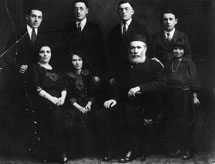Albert (Al) Wise, 90, has devoted most of his life to the landsleit of Stashov, the town in Poland where his family lived and where he was born in 1914.
His father, Benjamin Weisberg, a tailor, came to Canada in 1920, and two years later, he brought his wife, Al, and Al’s brother and sister.
Like many new Canadians, Wise’s father joined the Stashover landsmanshaft, where he served as president from 1932 to 1939.
Wise recalls that as a child, he was taken to the house on Dundas Street that served as Stashover’s synagogue and meeting place, where he later had his bar mitzvah.
“When I was 18, I had to become a member and it cost $2 a year,” he says.
When his father was dying, he asked his son to take care of the shul. And throughout his life, Wise has, with loyalty and love, dedicated a major part of his life to the survival of the Stashover organization.
In 1967, the Dundas Street location was sold and a new building was erected on Sultana Avenue, near Bathurst Street, south of Wilson Avenue, under the leadership of Morris Hauer, a builder. His son, Saul Hauer, is currently the organization’s president.
Wise now lives in a seniors’ residence and surrounds himself with photographs of his late wife, Ann, and his nieces and nephews. During an interview, he spoke of his early years — his house without a toilet, Friday night visits to the Harrison Steam Baths near Queen and McCaul streets, and as a young man, becoming involved with Stashover.
The nonagenerian reminisced about his sports activities, which included playing baseball for the Lizzies in 1929 and 1930, when the team won the city championship. Wise takes pride in the fact that he was one of the first people, in 1941, to organize a mixed bowling league, which was then almost unheard of — the Montrose Bowling League.
“I also played handball, basketball and hockey. My first pair of ice tubes [skates], which were new, cost me 50 cents from a peddler, but they were size 12 and I wore size 6. I had to stuff the toes for years and I only got to size 10. Then I passed them on to my brother.”
Wise attended Hester Howe Public School, now the location of the Hospital for Sick Children. He then went to Ryerson and Orde public schools.
“When I finished public school, I had to get a special permit from the board of education to work because we needed the money,” he says. “They gave me the permit, but I had to go to school two nights a week.”
Wise worked as a cutter in a dress factory, and in 1939, when there was a general strike, he followed the company to Montreal. He returned to Toronto in 1941 and founded a dress manufacturer, Klever Klad Dress Co. He left the company in 1943 to open, with his father, a ready-to-wear store on Yonge Street south of Bloor. The property was expropriated in 1955 for the subway.
“Ann [Layefsky] came to work for us in the store in 1941 and the following year we were married.” Ann died 11 years ago. They never had children, he says, but their nieces and nephews are close to him, and he considers them his children.
Gloria Roden, Wise’s niece, says, “Although he never had children, Uncle Al was always there for everyone. When you said you needed something, he was always there first.”
In 1970, Stashover amalgamated with the Slipia organization, and the congregation became known as Anshei Stashover-Slipia. Slipia was a town near Stashov. Wise says he continues to be active in the shul.
Jack Lipinsky, an educator who was hired as Stashover-Slipia’s ba’al koreh 23 years ago, and is the ba’al tfillah and ba’al musaf on the Yamim Nora’im, said that “it is unparalleled, to my knowledge, that Al Wise has volunteered for a shul for some 60 or 70 years.”
He adds that despite being a busy and successful businessman, Wise always made time for his shul. To this day, he takes care of the books, supervises repairs, is in the office to update the records and davens loudly, effectively and passionately.
“Despite his bluster, he is very modest about his role in the shul. As a historian, I honestly don’t know anyone else who has given six decades plus of their lives to a single institution with such singular loyalty, tenacity and colourful opinionatedness like Al,” Lipinsky says.
“He is truly unique — one of a kind — an institution in himself.”
Wise laments that the Stashover-Slipia building is now open only for Saturday morning services, on Sunday morning and for holidays.
“Although I have kept my promise to my father to keep the Stashover organization operating, I am fearful that the Stashover-Slipia and other shtetl-based groups will not survive.”
A conversation with Al Wise is like a walk down memory lane in the city of Toronto. ♦
This article appeared originally in the Canadian Jewish News and appears here courtesy of the author. © 2004 by Cynthia Gasner
Capsule History of the Stashover-Slipia Congregation
Among the many Jewish immigrants pouring into Toronto about a century ago were people from two small Polish shtetlach of Staszow and Slipi, who founded two independent small congregations about 1910. After the First World War, the congregations purchased houses—the Stashover on Dundas Street near Spadina, the Slipia on Oxford Street — and converted them into shuls.
Rabbi Graubart arrived from Staszow shortly after the war. He was a respected and learned man who authored books on Jewish law, opened a Yeshiva, and served as principal of the Eitz Chaim School on D’Arcy Street.
During the Second World War, the Jewish communities of Staszow and Slipi were devastated by the Nazi Shoah; after 1945, a few souls, remnants of far larger clans, trickled into Toronto and joined their landsleit. They arrived just as the Jewish community began to move northwards into the suburbs.
By the early 1960’s both the Stashover and Slipia Congregations found downtown membership dwindling. The Stashover moved first — to a building on Sultana Avenue in North York — and were joined by the Slipia Congregation a few years later. Through the 1960s and 1970s, the shul thrived in the vibrant centre of Toronto Jewish life.
But as the number of members dwindled through natural attrition, a slow decline began and services fell from twice a day to twice a week. Today the shul has been somewhat reinvigorated by some new members, attracted by the traditional friendly and familial atmosphere. The congregation celebrated its centenary in May 2010 with a festive banquet at the Park Hyatt.
For further information please visit the website of the Stashover Slipia Congregation at http://www.stashoverslipia.org/
According to a website on the Jews of Staszow (http://www.staszow.co.uk/staszowers_today.html):
| It seems that there are only two surviving Staszow landsmanshaftn across the globe. The biggest and most important is in Toronto, Canada. Toronto is probably the biggest centre of migration for the Staszow Jews. The first Staszowers went there in the beginning of the 20th century. The only other surviving landsmanshaft is in Montevideo, Uruguay. There used to be a very large and active Staszow landsmanshaft, in Tel Aviv, Israel, but I believe it was dismantled. |







